
Asimina is a genus of small trees or shrubs described as a genus in 1763.
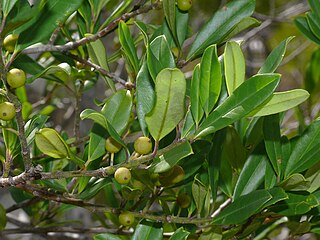
Ilex cassine is a holly native to the southeastern coast of North America, in the United States from Virginia to southeast Texas, in Mexico in Veracruz, and in the Caribbean on the Bahamas, Cuba, and Puerto Rico. It is commonly known as dahoon holly or cassena, the latter derived from the Timucua name for I. vomitoria.

Ilex verticillata, the winterberry, is a species of holly native to eastern North America in the United States and southeast Canada, from Newfoundland west to Ontario and Minnesota, and south to Alabama.
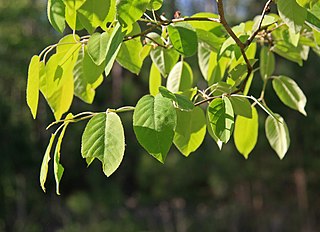
Amelanchier arborea, is native to eastern North America from the Gulf Coast north to Thunder Bay in Ontario and Lake St. John in Quebec, and west to Texas and Minnesota.

Vaccinium angustifolium, commonly known as the wild lowbush blueberry, is a species of blueberry native to eastern and central Canada and the northeastern United States, growing as far south as the Great Smoky Mountains and west to the Great Lakes region.

Vaccinium corymbosum, the northern highbush blueberry, is a North American species of blueberry which has become a food crop of significant economic importance. It is native to eastern Canada and the eastern and southern United States, from Ontario east to Nova Scotia and south as far as Florida and eastern Texas. It is also naturalized in other places: Europe, Japan, New Zealand, the Pacific Northwest of North America, etc. Other common names include blue huckleberry, tall huckleberry, swamp huckleberry, high blueberry, and swamp blueberry.

Sorghastrum nutans, commonly known as either Indiangrass or yellow Indiangrass, is a North American prairie grass found in the central and eastern United States and Canada, especially in the Great Plains and tallgrass prairies.
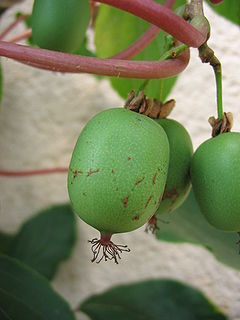
Actinidia arguta, the hardy kiwi, is a perennial vine native to Japan, Korea, Northern China, and Russian Far East. It produces a small kiwifruit without the hair-like fiber covering the outside, unlike most other species of the genus.

Vaccinium darrowii, with the common names Darrow's blueberry, evergreen blueberry, scrub blueberry, or southern highbush blueberry, is a species of Vaccinium in the blueberry group.

Vaccinium elliottii is a species of Vaccinium in the blueberry group. It is native to the southeastern and south-central United States, from southeastern Virginia south to Florida, and west to Arkansas and Texas.
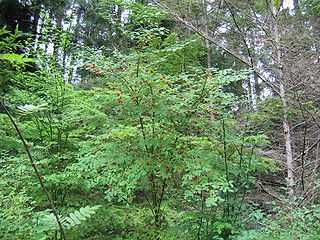
Vaccinium parvifolium, the red huckleberry, is a species of Vaccinium native to western North America, where it is common in forests from southeastern Alaska and British Columbia south through western Washington and Oregon to central California.
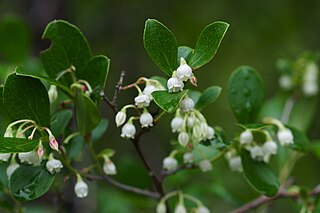
Vaccinium arboreum is a species of Vaccinium native to the southeastern and south-central United States, from southern Virginia west to southeastern Nebraska, south to Florida and eastern Texas, and north to Illinois.

Rubus ursinus is a North American species of blackberry or dewberry, known by the common names California blackberry, California dewberry, Douglas berry, Pacific blackberry, Pacific dewberry and trailing blackberry.

Vaccinium stamineum, commonly known as deerberry, tall deerberry, squaw huckleberry, highbush huckleberry, buckberry, and southern gooseberry, is a species of flowering plant in the heath family. It is native to North America, including Ontario, the eastern and central United States, and parts of Mexico. It is most common in the southeastern United States.

Blueberries are perennial flowering plants with blue or purple berries. They are classified in the section Cyanococcus within the genus Vaccinium. Vaccinium also includes cranberries, bilberries, huckleberries and Madeira blueberries. Commercial blueberries—both wild (lowbush) and cultivated (highbush)—are all native to North America. The highbush varieties were introduced into Europe during the 1930s.

Vaccinium ovalifolium is a plant in the heath family having three varieties, all of which grow in northerly regions, including the subarctic.

Solanum physalifolium, known as hoe nightshade, Argentine nightshade, green nightshade and hairy nightshade, is a species in the family Solanaceae. Native to Argentina, Bolivia and Chile, it is widely naturalized in Australia, New Zealand, Europe, western Canada and the north western United States. Solanum physalifolium has been widely but incorrectly known as Solanum sarrachoides, a different species. It has been listed as a noxious weed in the US states of Kansas and Michigan under this misapplied name.

Solanum rostratum is a species of nightshade that is native to the United States and northern and central Mexico. Common names include buffalobur nightshade, buffalo-bur, spiny nightshade, Colorado bur, Kansas thistle, bad woman, Mexican thistle, and Texas thistle.
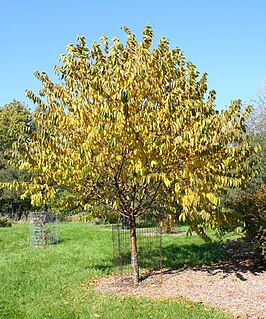
Prunus maximowiczii, known as Korean cherry, Korean mountain cherry, or Miyama cherry, is a small, fruiting cherry tree that can be found growing wild in northeastern Asia and Eurasia.

Blitum is a genus of flowering plants in the amaranth family Amaranthaceae, subfamily Chenopodioideae. It is closely related to genus Spinacia. Its 12 species were traditionally placed in the genera Chenopodium, Monolepis, or Scleroblitum. The species of genus Blitum occur in Asia, Europe, North Africa, the Americas, and Australia.





















